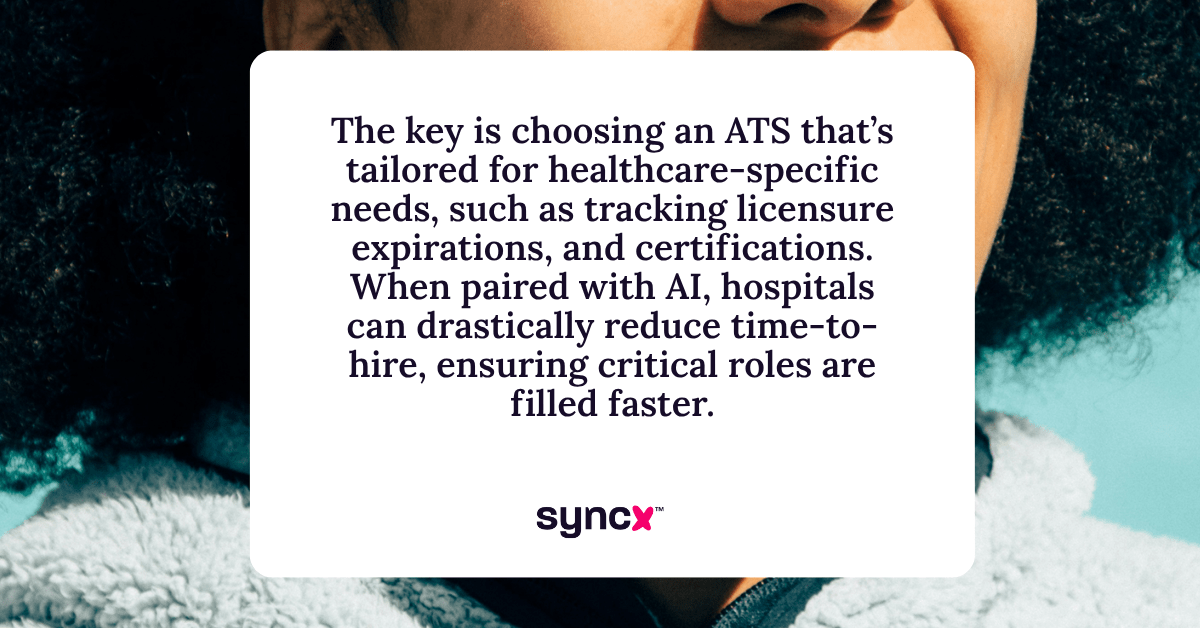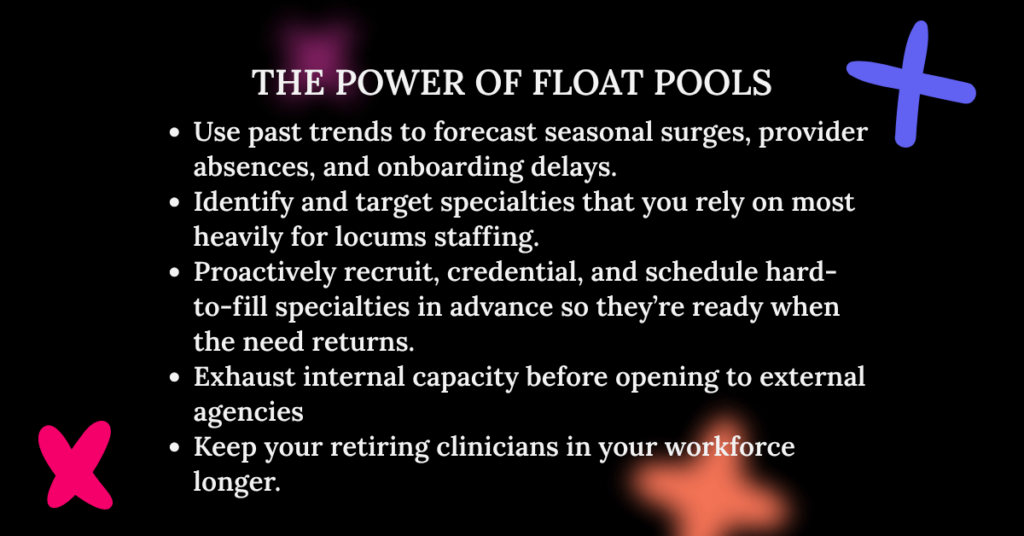How to Fix Staffing Shortages in Healthcare: 10 Solutions
Hospital staffing shortages have become a chronic condition in healthcare that no amount of temporary fixes can cure. The exhaustion of frontline workers, the reliance on costly agency staff, and the constant scramble to fill shifts are symptoms of deeper systemic challenges that demand more than incremental solutions.
This isn’t just a recruitment problem. It’s a structural issue that touches everything from workplace culture and technology to training pipelines and mental health support. Hospitals that are making progress aren’t just hiring faster; they’re redesigning how they attract, retain, and support their workforce.
In this article, we explore strategies that go beyond conventional approaches—leveraging technology to streamline hiring, optimizing workforce utilization, strengthening internal mobility, and fostering environments where clinicians can thrive rather than just endure. The solutions exist. The question is whether we’re willing to rethink the status quo.

1. Align Your Technology Stack
From your ATS to your scheduling software, disjointed systems slow everything down. Unifying the tech experience ensures recruiting, onboarding, and managing talent feels seamless. A great place to start is with an Applicant Tracking System (ATS) designed for healthcare. These can transform recruitment by automating resume screening, credential verification, and interview scheduling. Most ATS platforms integrate with professional networks and job boards, optimizing fill rates. A system like Syncx Perm ATS offers even more – like automated approval workflows and job order management to text alerts. It also utilizes AI to help write job descriptions, customize candidate emails, create nurture campaigns, and automate manual tasks.
The key is not just adopting an ATS but choosing one that’s tailored for healthcare-specific needs, such as tracking licensure expirations, specialty certifications, and even seasonal demand fluctuations. When paired with AI, hospitals can drastically reduce time-to-hire, ensuring critical roles are filled faster.
2. Look into Software that Improves Utilization Rates
Staffing shortages are often worsened by inefficient scheduling like providers working excessive overtime while others sit underutilized. The solution isn’t just hiring more staff but optimizing existing workforce capacity through intelligent scheduling tools.
Vendor Management Systems (VMS) and workforce management platforms can provide powerful analytics tools for insights into staffing trends and inefficiencies. For example, Syncx VMS is a purpose-built locum tenens staffing solution that delivers greater scheduling visibility and powerful reporting metrics on an intuitive platform. Such tools allow facilities to place locums faster, optimize performance, and boost their bottom line.
Some hospitals heavily leverage the candidate analytics dashboards, to allow recruiters and managers across the system to see candidates that may have applied to the system but have not been interviewed by a specific department or hospital. This prevents the all-too-common scenario where one department is overstaffed while another scrambles for coverage.
3. Build a “Float First” Model
External locum tenens providers are a common stopgap, but they come at a premium, and can disrupt continuity of care. Before jumping to agencies, create an internal float pool of physicians who know your system. Retired providers, part-time clinicians, and new hires can all help cover gaps with less friction and lower cost.
This approach allows you to take a variety of proactive approaches to temporary staffing:
- Use past trends to forecast seasonal surges, provider absences, and onboarding delays.
- Identify and target specialties that you rely on most heavily for locums staffing.
- Proactively recruit, credential, and schedule hard-to-fill specialties in advance so they’re ready when the need returns.
- Exhaust internal capacity before opening to external agencies
- Keep your retiring clinicians in your workforce longer.

4. Think Like a Candidate, Not Just an Employer
Top physicians have options. Recruitment efforts need to feel different—fast follow-up, personalized outreach, and transparent expectations win attention in a noisy market. Too many hospitals still approach hiring like a bureaucratic process rather than a strategic courtship. The best candidates aren’t just evaluating a job description; they’re assessing whether your organization values their time, expertise, and career trajectory. When every interaction reflects respect for their decision-making process, hospitals stand out in a sea of generic opportunities.
The difference often comes down to operational empathy. A physician considering a career move isn’t just looking for competitive compensation; they want clarity on scheduling autonomy, leadership support, and how their specialty fits into the broader care model. Hospitals that articulate these details early build trust before negotiations even begin.
5. Expand the Careers Section of Your Website
A hospital’s online presence often serves as the first impression for potential hires, yet many career pages function as passive job boards rather than strategic recruitment tools. In today’s competitive labor market, healthcare organizations must transform their digital footprint into an engaging showcase of organizational culture and professional growth opportunities.
Thoughtfully designed career portals do more than list openings—they tell a story. Virtual unit tours and day-in-the-life narratives help candidates visualize their future roles beyond the job description. Authentic testimonials from current staff, particularly those who have advanced their careers internally, carry far more weight than generic benefits summaries. Beyond strategic content, you can also implement enhancements like job schema so that your pages appear in advanced search results for job seekers, letting you reach a wider online audience.
Finally, the most effective career sites integrate directly with applicant tracking systems, using smart algorithms to recommend roles based on a candidate’s experience and interests. Integrating systems can help you reduce manual postings and tracking, which ultimately will help connect with candidates more quickly and allow recruiters to focus more on important connections, rather than manual administrative tasks
6. Focus on Retention
The revolving door of healthcare staffing cannot be closed through recruitment alone. Retention must be approached with the same rigor as patient outcomes, recognizing that each departing employee represents not just a vacancy but lost institutional knowledge and team cohesion. Sustainable retention requires moving beyond transactional perks to address the structural factors that push staff toward the exit.
Flexibility has emerged as a non-negotiable retention tool, with self-scheduling options and hybrid roles helping to accommodate the diverse needs of today’s healthcare workforce. Similarly, a strategic examination of contingent labor often reveals retention opportunities. Partnering with managed service providers to audit temporary staffing usage can uncover over-reliance on agencies as a symptom of deeper retention issues. Converting long-term contingent staff to permanent positions with retention incentives frequently proves more cost-effective than perpetual agency use. Similarly, internal float pools are a fantastic way to keep retired providers inside of your system, retaining crucial talent and organizational memory.
Furthermore, career development must extend beyond traditional promotion tracks. Many clinicians seek growth without abandoning direct patient care, creating demand for leadership roles, education, or technology-integrated roles. Hospitals that provide these “career lattices” retain valuable expertise while keeping work intellectually stimulating for long-term staff.
7. Launch a Referral Engine
Your most powerful recruitment tool may already be on your payroll. Current providers naturally connect with peers who share their clinical standards and work ethic, making employee referrals one of the highest-quality talent pipelines available. Yet many hospital referral programs remain underutilized due to cumbersome processes or lackluster incentives.
The difference between an average referral program and a high-performing one lies in its design. A truly effective system provide the right financial incentives while also tapping into professional pride, recognizing contributors publicly and highlighting how their referrals strengthen the care team. When paired with prompt follow-up on every lead, this approach turns cold recruiting into warm introductions, dramatically improving both candidate quality and hiring speed.
8. Stop Letting Good Candidates Slip Away
Too many healthcare systems lose candidates midstream. The most sought-after physicians and advanced practitioners won’t wait through weeks of disjointed interviews and delayed decisions. The solution lies in overhauling recruitment workflows to eliminate bottlenecks that frustrate top talent.
Centralizing job visibility is the first critical step. When hiring managers, department chairs, and recruiters access real-time candidate data in a unified system, approvals accelerate dramatically. Shortening feedback loops matters equally—structured interview timelines with 48-hour debriefs prevent the silence that makes candidates question an organization’s interest. In today’s market, hesitation is far costlier than moving quickly on the right candidates.
9. Compete on Flexibility, Not Just Compensation
While competitive salaries remain important, today’s healthcare professionals increasingly want control over their schedules and work environments. The hospitals winning the talent war understand that flexibility has become the new currency. This shift recognizes that burnout often stems not just from workload volume, but from the inability to balance professional and personal commitments.
Forward-thinking organizations embed flexibility into their operational DNA rather than treating it as occasional exceptions. Some allow experienced providers to design their own FTE commitments annually, while others create internal float pools that let clinicians rotate between departments based on interest and capacity. When providers feel genuine autonomy over their professional lives, retention improves organically.
10. Invest in Data-Driven Workforce Planning
Reactive staffing approaches will always lag behind healthcare’s dynamic demands. Leading hospitals now treat workforce planning with the same analytical rigor as financial forecasting, using historical trends and predictive modeling to anticipate needs before crises emerge. This means moving beyond traditional provider-to-patient ratios to incorporate variables like seasonal admission patterns, upcoming retirements, and even local competitor hiring activity into staffing strategies.
With real-time vacancy data, hospitals can proactively adjust recruitment pipelines, float pool allocations, and training programs. The result is a strategic advantage: organizations that can staff to true demand curves rather than playing constant catch-up. In an era where staffing stability directly impacts care quality and financial health, data literacy becomes as critical as clinical expertise for healthcare leaders.
Ready to Upgrade Your Temporary Workforce Management?
Do you want to transform your hospital’s staffing challenges into sustainable solutions? Syncx offers a smarter approach with locums MSP services to streamline contingent labor, an AI-powered ATS built for physician hiring, and an on-demand float pool of physicians and advanced practitioners to fill gaps efficiently.
See how our integrated platform reduces reliance on costly agencies, cuts time-to-fill, and optimizes your workforce—book a demo today and discover a better way to staff smarter.